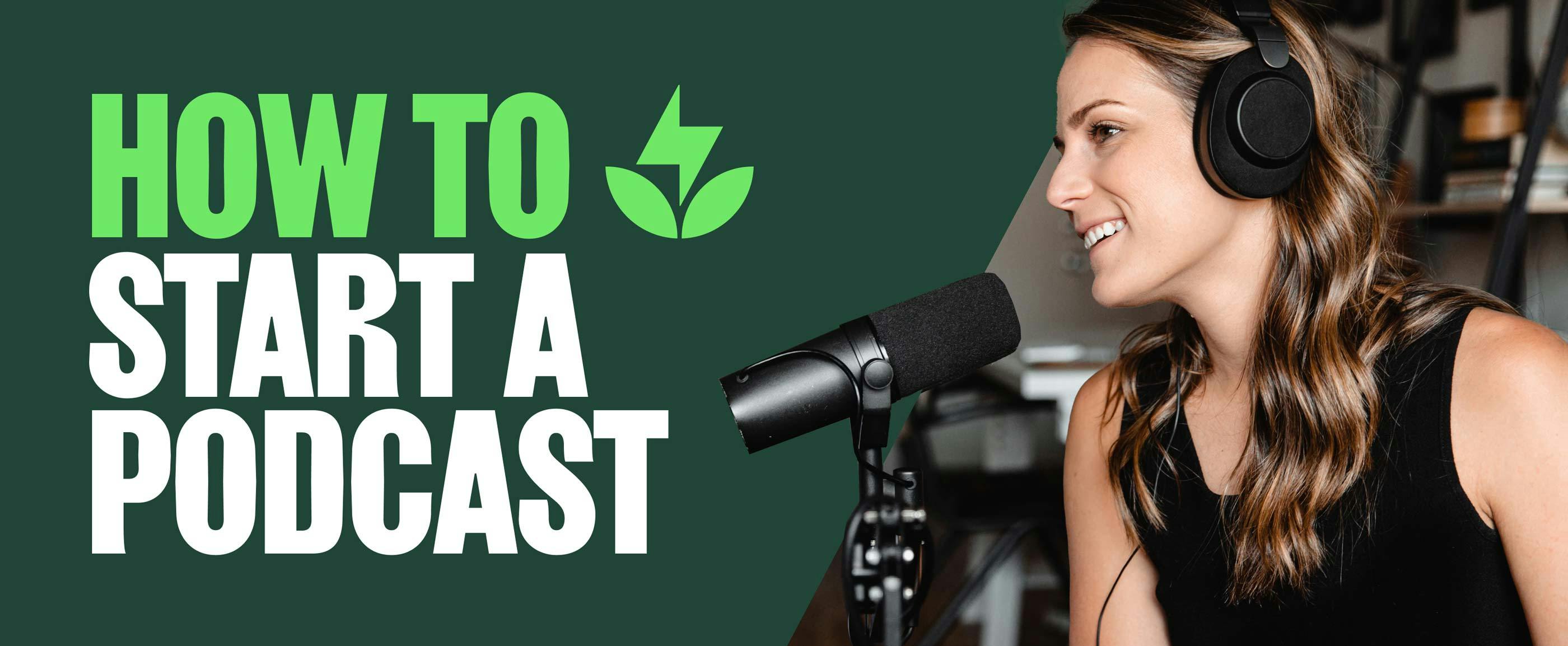
How to Start a Podcast: Complete Step-by-Step Guide [2025]
Launching a podcast can feel overwhelming if you're doing it by yourself, but you don't have to do it alone.
Since 2009, Buzzsprout has helped over 300,000 podcasters launch their podcast, and we've used everything we've learned to create this guide.
We broke this guide into 10 easy steps that give you everything you need to confidently create, launch, and grow a great podcast!
1. Develop a podcast concept
Choosing the right podcast concept for your new podcast is a big part of attracting the right listeners and staying committed to your show.
Follow these tips to narrow your niche and clarify your message.
Define your goals
Why do you want to start a podcast? It’s important to know your why, even if it’s to have fun with friends.
Some good reasons for starting a podcast are:
- to generate leads for a business
- be recognized as an industry leader
- share an important message
Podcasting has a lot of benefits for brands and businesses, but it’s important to be realistic about your goals.
While some podcasters shoot to fame, most have a small target audience that they build over time.
Pick a podcast theme or topic
You should feel excited to regularly discuss and research your podcast topic. The more you enjoy your topic, the less likely you'll experience podfade.
Once you have some ideas, do some market research to survey the competition in your genre.
Search your show's topic in Apple Podcasts. Listen to a few episodes and ask yourself what you could do differently.
There’s always a unique angle or perspective to offer.
PRO TIP
To test out your own podcast concept, try to come up with ten episode ideas. If ideas don’t come easily, you might want to change topics.
Make it specific
When you zero in on a niche, you attract a more specific and engaged audience. Podcasts that appeal to a broad audience can end up reaching fewer people.
People are also more likely to recommend a niche podcast to a friend than a generic one.
To make your podcast niche, focus on a sub-category or sub-demographic.
Drill down on what makes your podcast different. What unique perspective can you bring to your podcast’s topic?
EXAMPLES OF FINDING A NICHE
- Mental health → Mental health for lawyers
- Drones → Drone racing
- Nutrition → Nutrition for diabetics
- Personality tests → Enneagram in the workplace
- Business → How to start a nonprofit
Name your podcast
Your podcast name is a core part of your brand. It makes a strong first impression on listeners and sets the tone for your podcast.
Here's Apple's advice on how to name your podcast:
It’s important to have a clear, concise name for your podcast. Make your title specific. A show titled Our Community Bulletin is too vague to attract many subscribers, no matter how compelling the content. Pay close attention to the title as Apple Podcasts uses this field for search.
Podcast names should have the following characteristics:
- specific and succinct
- available
- memorable
- similar to your business name or brand
Once you have a title in mind, run it through a podcast name checker to ensure the social media accounts and domains are available. You also don't want to use someone else's podcast name.
PRO TIP
Don't create podcast artwork, yet. You'll tweak your podcast concept before you release your episodes, and you don't want to have to redo your artwork.
2. Choose your podcast format
Your format should complement your podcast and feel sustainable.
Ask yourself what gives you energy. Do you love connecting with podcast guests, or do you feel your best going solo?
If you choose to have cohosts, try to keep your group small. Podcasting with more than two or three people makes scheduling a challenge.
Keep in mind that some shows require more production than others. For instance, fiction podcasts usually require more editing than interview podcasts.
These are some common podcast formats:
- interview podcasts
- cohosted podcasts
- scripted non-fiction
- news recap
- educational podcasts
- scripted fiction
Optimal podcast episode length
Make your episodes as long as they need to be and no longer.
Some podcasts are less than five minutes long, and others have episodes the length of a short audiobook. Here are the most common episode durations:
- less than 10 minutes (14%)
- 10—20 minutes (15%)
- 20—40 minutes (31%)
- 40—60 minutes (22%)
- Over 60 minutes (7%)
SOURCE: Buzzsprout Platform Statistics
Podcast publishing schedule
Podcasting can be a full-time job or something you do on the side. You might decide to publish daily or every two years like Serial.
We recommend publishing once a week to develop a connection with listeners and create the habit of producing consistent content. These are the most common publishing frequencies:
- 0—2 days (7%)
- 3—7 days (36%)
- 8—14 days (39%)
- 15—29 days (17%)
- Over 30 days (1%)
SOURCE: Buzzsprout Platform Statistics
3. Setup podcast recording equipment
You don’t have to buy expensive equipment to have good audio. Lots of popular podcasts have a basic setup.
Let’s review what to look for in a podcast microphone. Then, we’ll make our top podcast equipment recommendations.
Best podcast microphones
A good podcast mic enhances your audio quality and makes editing easier. Less background noise in your recording means less editing on the backend.
Here are a few to consider before getting your first podcast mic. Our top recommendation is the Samson Q2U which you can buy on Amazon for about $70.
Dynamic or condenser
Dynamic microphones work best for podcasting. They pick up lower frequencies and have less sensitivity. This means you’ll have less background noise to edit out later.
Condenser mics have more sensitivity and pick up a wider range of frequencies. Sensitivity is good for recording music but isn’t ideal for spoken word.
XLR or USB
Podcast mics have two types of connections: XLR or USB.
XLR mics give you maximum flexibility. There are a lot of XLR mics to choose from, and they usually have a long life. But XLR mics require an interface or mixer to hook up. This can get expensive for beginners.
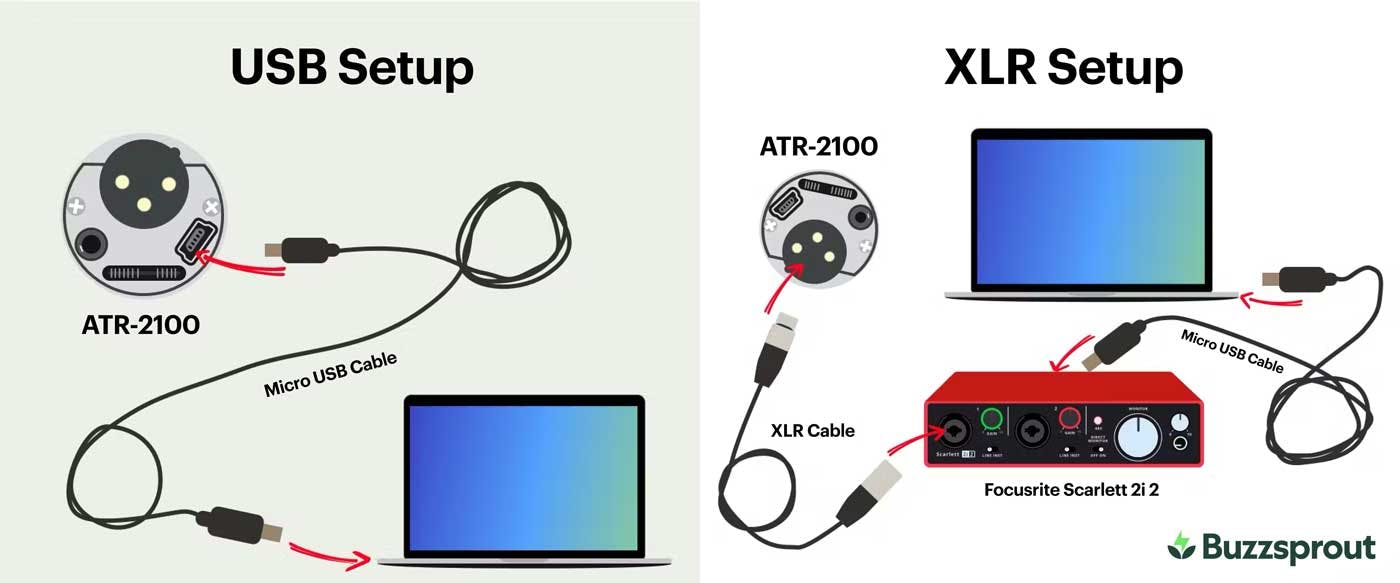
USB microphones are less expensive and plug directly into your computer. You can also run it through an interface if you record with multiple people.
USB mics are affordable, practical, and sound great. This mic is the best option for the majority of podcasters.
TOP MIC RECOMMENDATIONS:
- Samson Q2U | $70
- Podmic | $150
- Shure SM7B | $400
Example podcast setups
1. One-person setup ($70)
- Samson Q2U | $70
- Any headphones you already have
2. Two-person setup ($400)
- Samson Q2U | $70 (x2)
- Audio Technica M20x | $50 (x2)
- Focusrite Scarlett 2i2 | $165
3. Three-to-four-person setup ($960—$1,080)
- Samson Q2U | $70 (x3 or 4)
- Audio Technica M20x | $50 (x3 or 4)
- RODECaster Pro | $600
At $150, the Zoom P4 is a cost-conscious replacement for the RODECaster Pro.
RECOMMENDED ACCESSORIES:
- RODE PSA1 Boom Arm | $110
- Shock mount | $35-50
- Foam ball or pop filter | $6—$10
RELATED YOUTUBE VIDEOS
4. Choose your podcast software
Once you've recorded your podcast, it's time to make edits. This is where you can structure your episode and optimize audio.
Fortunately, podcast editing software is often affordable. There are even some high-quality, free podcast editing tools.
Remote recording software
If you frequently do remote interviews, you'll need software specifically for long-distance recordings.
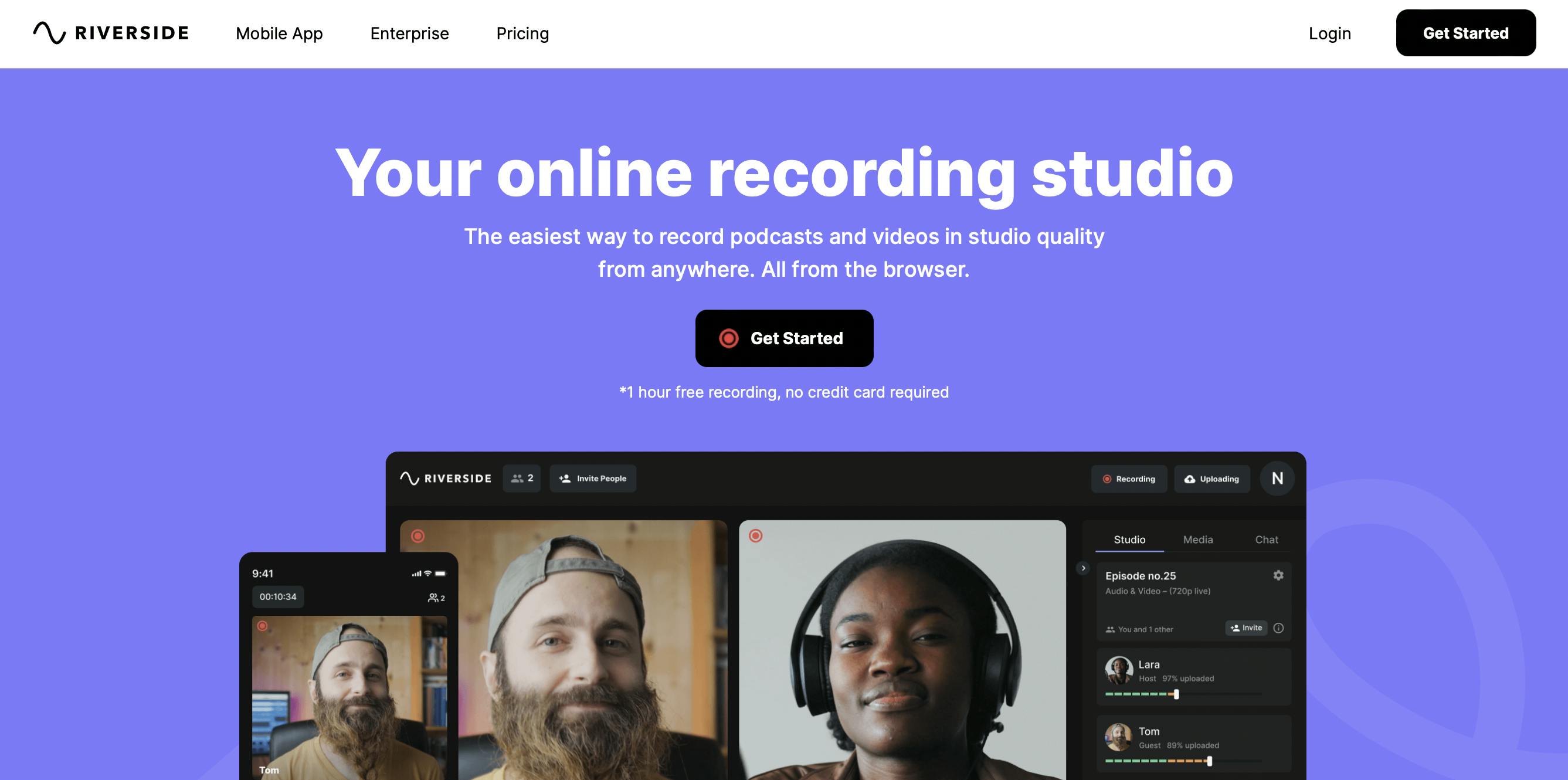
1. Riverside.fm
- Cost: $15+ per month
- Studio-quality recordings
Riverside allows you to record local audio and video, even if you don't have a great internet connection.
Users can take listener call-ins, live stream to social media, and edit videos within a browser. Files continuously upload to the cloud during recording, so you never lose your work.
2. SquadCast
- Cost: $12+ per month
- Studio-quality recordings
SquadCast makes it easy to set up a remote podcast interview and capture high-quality, lossless audio.
Squadcast's sound quality is much better because it records local WAV files to each person’s computer. The initial setup is more complicated than Zoom, but this tutorial can help.
3. Zoom
- Cost: Free - $18/month
- Average recording quality
- Most guests have experience with Zoom
Zoom is a go-to remote recording tool with average audio quality. And most people already know how to use it.
The app’s default features compress audio, but you can improve the audio by using the best settings for Zoom recordings.
PRO TIP
Don't use Skype to record your podcast. Skype calls are typically much more compressed and of lower quality than the other options.
Editing software
1. GarageBand | Free
- Difficulty: Beginner
- Compatibility: Mac and iOS
GarageBand comes pre-installed on most Apple computers. If you don't have it, you can easily download it for free. We think GarageBand is a more intuitive interface than Audacity.
GarageBand is not available on Windows computers or Android phones. This tutorial can help you learn how to navigate the workspace.
2. Audacity | Free
- Difficulty: Moderate
- Compatibility: Mac, Windows, and Linux
Audacity is a free, open-source audio editor with pro-level features. This DAW is more than enough for most podcasters to produce great episodes.
Audacity has a steeper learning curve than GarageBand, but we have many Audacity tutorials to help you navigate the platform.
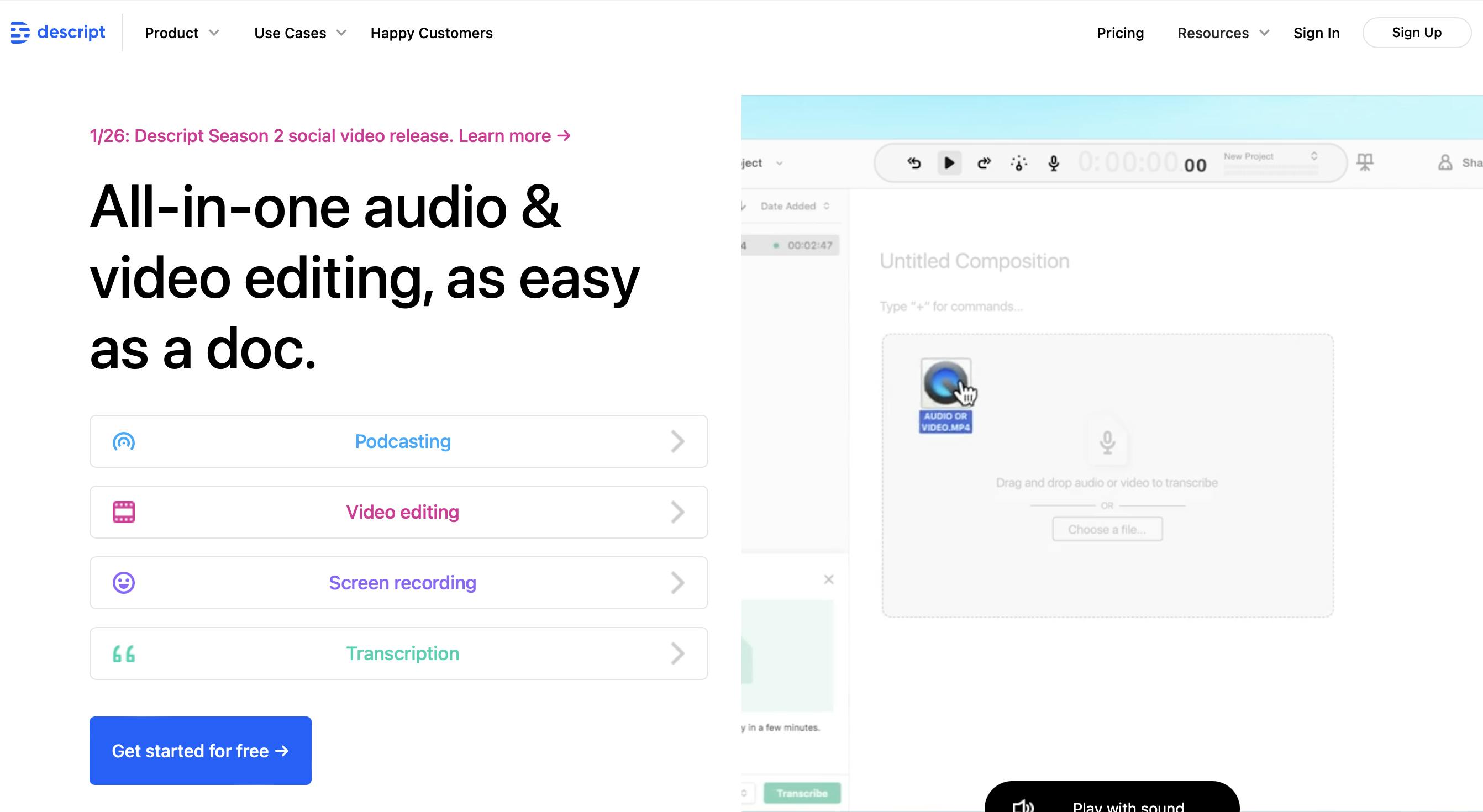
3. Descript | $12+ per month
- Difficulty: Moderate
- Compatibility: Mac and Windows
Descript is an all-in-one editing tool that lets you record, transcribe, mix, and edit your audio files like you would a text document.
Descript can automatically remove filler words and dub over a phrase with text-to-speech voice cloning.
This Descript tutorial shows how to use the video and screen recording feature and the in-browser editing suite.
4. Hindenburg Pro | $12 per month
- Difficulty: Moderate
- Compatibility: Mac and Windows
Hindenburg is a pro-level audio editing software designed specifically for podcasters and journalists.
The workspace features simple tools made for spoken word and automated options to streamline your workflow. This Hindenburg walkthrough gives you an idea of the workspace.
Alternatives:
Other podcast software
These tools aren’t required but can improve your workflow and help optimize your content.
1. Cohost AI | Starting at $10 per month
Buzzsprout's Cohost AI tool will allow you to use AI to build out the details of your episodes. We have built Cohost AI into Buzzsprout to make your upload process easier and more streamlined, allowing you to focus more on your episode content.
While your episode is processing, Cohost AI will be handling the details. Cohost AI will give you episode title ideas, draft an episode description, define chapters, transcribe your episode, write some social content, and even draft a blog post!
Then, you can use that content to build out the rest of your episode details.
2. Magic Mastering | Starting at $6 per month
Magic Mastering automatically levels out and optimizes your audio file, like an Instagram filter for your podcast.
This tool helps simplify your workflow and guarantees your podcast meets industry best practices.
3. Audio Hijack | $64 one-time fee
Audio Hijack lets you record audio from any website or application and save it as an audio file.
Audio Hijack is an excellent option for live streaming with Twitch, StreamYard, or Facebook Live.
RELATED YOUTUBE VIDEOS
5. Record your first episode
Recording your episode requires a little preparation on the front end. Follow these three steps to set yourself up for success.
1. Write a podcast outline
Rambling is one of the most common mistakes new podcasters make, and the best way to fight this tendency is by writing a podcast script or outline.
Even taking a few minutes to jot down a list of bullet points will dramatically improve the flow of your episode.
If you're working with a cohost, share the outline with them so you can work on it together.
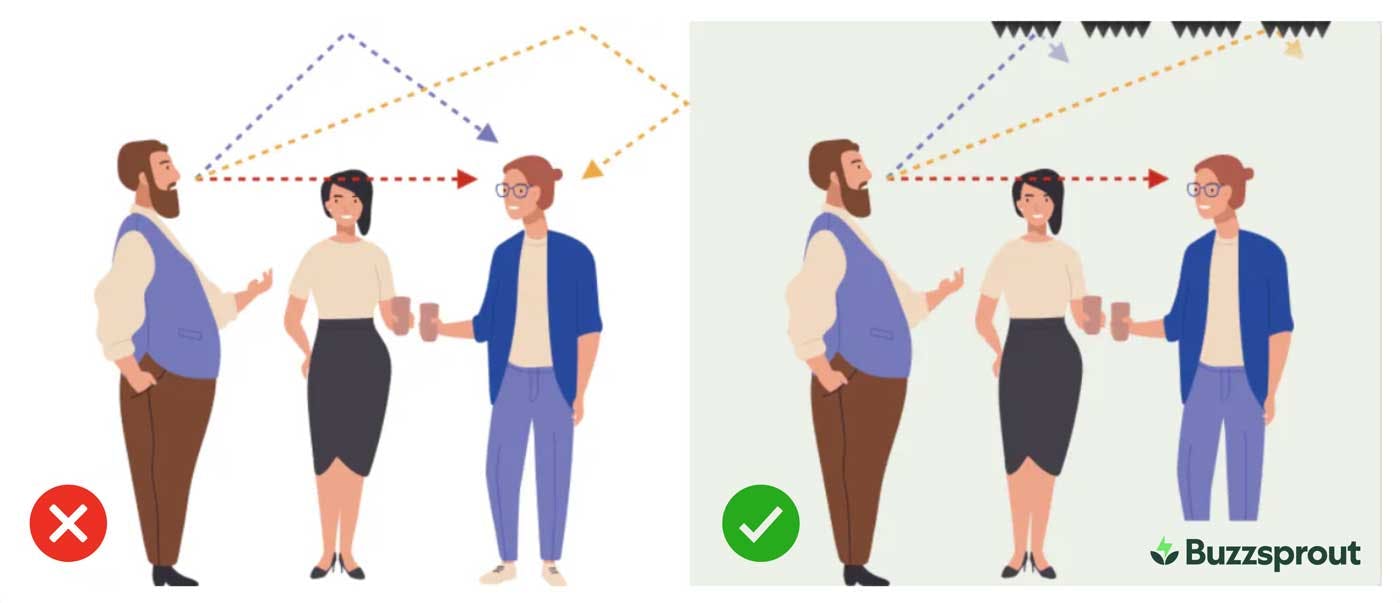
2. Pick a good place to record
If possible, record in a quiet room with lots of furniture, curtains, rugs, or carpet.
Noise bounces off of hard, flat surfaces, so eliminate these where you can. You can also sound treat your space with foam panels on the walls.

3. Set up your recording equipment and software
Connect your mic to your computer or audio recording device.
If you have a USB mic, plug the cable into your computer’s USB port. If you have multiple hosts, run each mic through an audio interface and plug the interface into the computer.
If you have an XLR mic, connect its cable to a USB interface or an external audio recording device like the Podtrak P4.
Once plugged in, go to your audio editing software settings and select your audio input.
Microphone technique
Position your mouth 2" to 4" away from the microphone for the cleanest sound, but the optimal distance may vary based on your microphone.
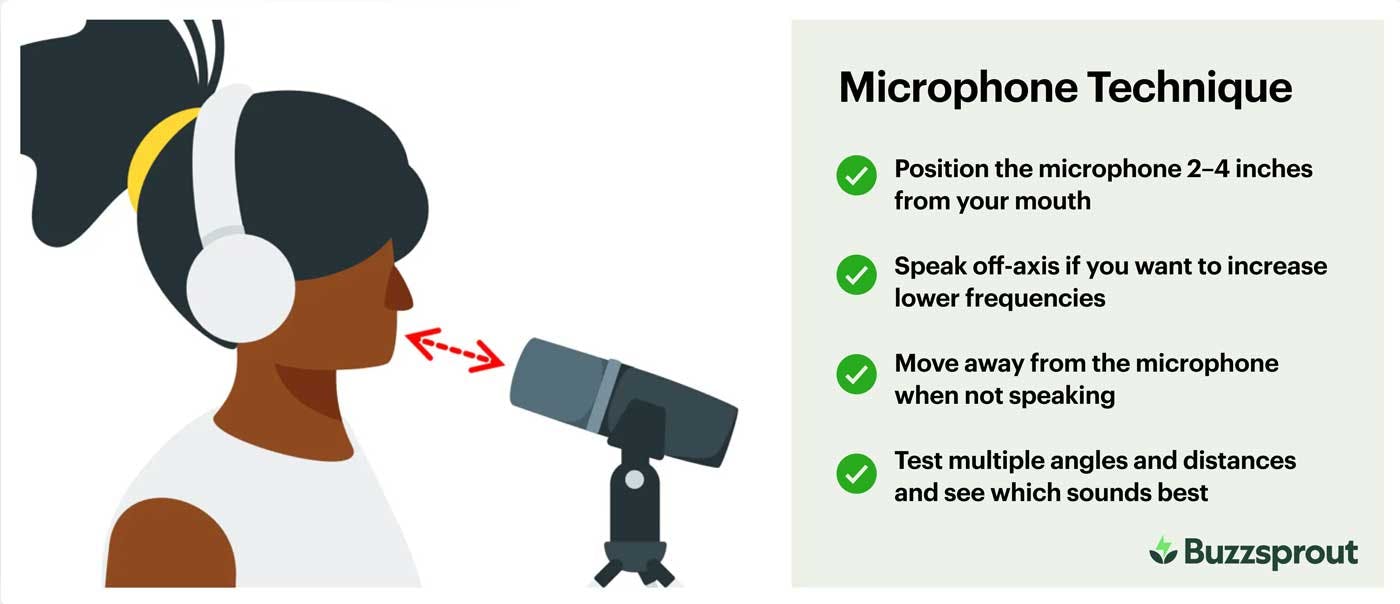
If you notice too many plosives or harsh sibilance in your recordings, the simplest solution is to move off-axis from the microphone.
Set your mic up to the side, angled slightly toward your mouth. This adjustment prevents bursts of air from hitting the capsule and results in more natural audio.
Record test track
Try recording yourself talking at a consistent volume at several different positions. Then, listen to the recording to see which position gave you the best audio quality.
Don't worry about mistakes, stammers, or silence. You can make your edits in the next step.
6. Edit your audio
Podcast editing is primarily for cleaning up the audio and making basic changes to the structure. Try to keep the process simple. If you focus too much on production, you'll get overwhelmed.
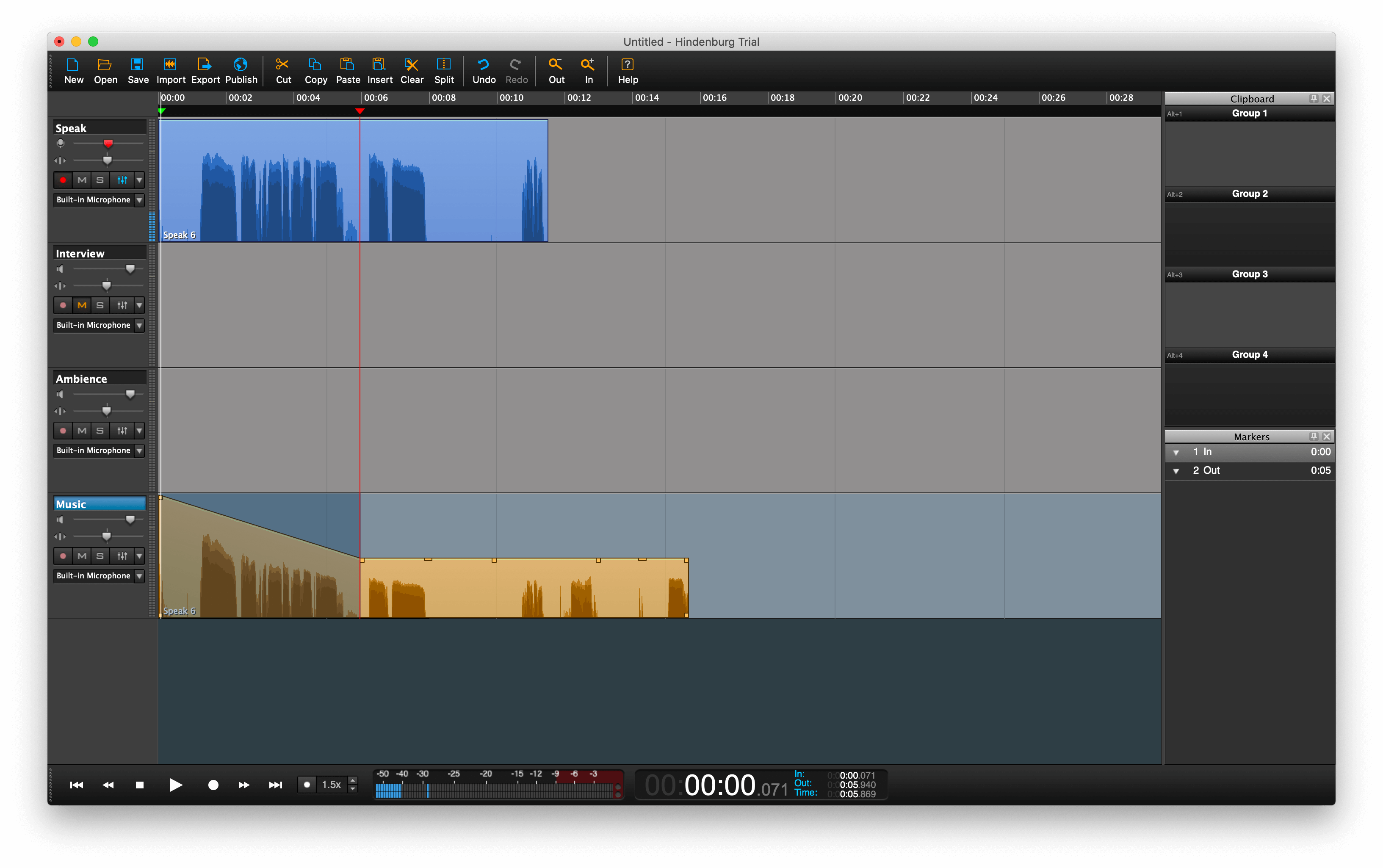
Follow these four tips to streamline your editing workflow.
1. Create an engaging intro and outro
Your podcast intro tells your audience what you’re about, and the value your podcast brings. When done well, your intro hooks listeners and convinces them to stick around for the whole episode.
You can get royalty-free music for no cost or purchase your show's intro music through one of these resources:
2. Edit for content, then distractions
Edit for content on your first pass and work on noise issues or other distractions on your second go-around.
If you focus on noise issues too early, you might polish sections you remove later on. Focus on getting the content right first, then double back to fix audio issues.
3. Fade between tracks to remove unwanted noise
When you cut sections of audio, you can sometimes get little pops or clicks in the finished product.
Use the fade tool at the beginning and end of clips if you run into those issues.
4. Create a punch-list
If you don't want to listen to an entire episode multiple times, create a list of audio distractions to check during your second pass.
This list can save time and ensure you don’t miss anything.
RELATED YOUTUBE VIDEOS
Export audio file
After you edit your podcast, export it as a .WAV file. Buzzsprout will automatically add ID3 tags and convert your file to the correct file format.
If you use another podcast hosting platform like Spotify for Podcasters, you'll need to export your file in the format your hosting site recommends.
PRO TIP
Don't worry about ID3 tags. Buzzsprout will add the correct ID3 tags to your audio files and RSS feed automatically.
7. Create podcast artwork
Your podcast cover art is the first thing potential listeners see on Apple Podcasts or social media.
Good artwork implies quality content, and 62% of new listeners are more likely to listen to a podcast if they like its cover art.
Your podcast artwork should follow these technical specifications based on Apple’s Podcast Artwork Requirements:
- square Image (3000 x 3000 pixels)
- resolution of 72 dpi
- PNG or JPEG file types
- colorspace RGB
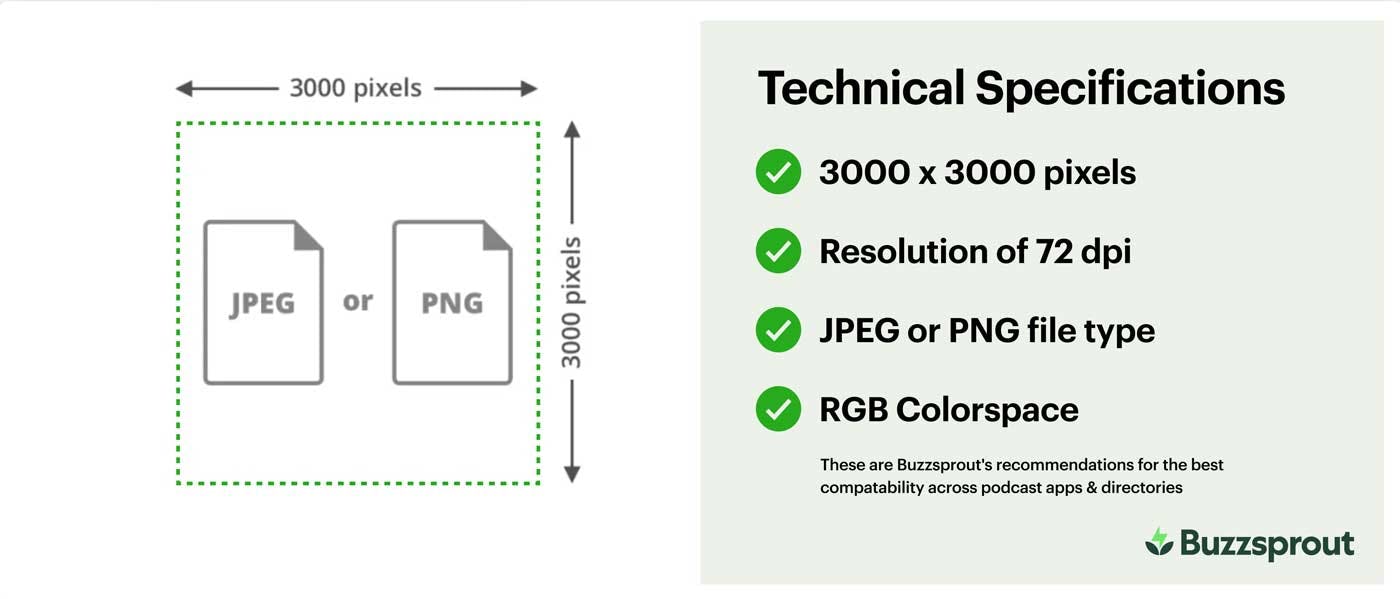
5 Tips to make your podcast artwork stand out
Follow these five tips to make artwork that stands out in podcast directories and attracts new listeners.
- Visually communicate the subject of the podcast. Potential listeners should know what your podcast is about just by looking at your artwork. Too much symbolism or ambiguity can turn people away.
- Design for a variety of sizes. You will use your artwork across several mediums and platforms, so it must look good even at 55 x 55 pixels.
- Don’t use too many words or fonts. Don't use more than four words on your cover art, and make sure it's legible even in small sizes. You should also limit yourself to two complementary fonts.
- Avoid podcast imagery. Just as movie covers don't have pictures of DVDs and TV sets, your podcast cover art shouldn't show podcasting equipment. You don’t need to remind people that they’re listening to a podcast!
- Use consistent branding. Your podcast artwork is a part of your overall branding. Feel free to make subtle changes to artwork to fit various layouts and pages, but the imagery should stay consistent.
Tools to design your podcast artwork
Buzzsprout's Canva integration
Buzzsprout's Canva integration allows you to create your own podcast cover within your Buzzsprout account.
Choose from 250,000+ templates, edit the template to match your podcast brand, and click Send to Buzzsprout.
Using this tool automatically guarantees that your cover art meets the spec requirements for every podcast app.
Adobe Creative Cloud Express (previously Adobe Spark) is a free service similar to Canva.
Create a free account and browse a catalog of templates, text styles, and color palettes to design your unique podcast logo. When you’re done, download your file as a .jpg or .png.
Fiverr is a more affordable way to outsource your artwork. Prices vary based on the experience of the designer.
Make sure you pick a designer with examples of good artwork in their portfolio.
99Designs lets you run a contest where designers compete to create the best design. Designers submit their ideas based on your guidelines, and you pick your favorite!
You can use this link for $20 off any contest.
8. Set up podcast hosting
A podcast hosting service like Buzzsprout stores your audio files and distributes them to podcast platforms so listeners can find your show in directories like Apple Podcasts.
You can try Buzzsprout free for 90 days to see how you like it. Then, follow these steps to set up your account!
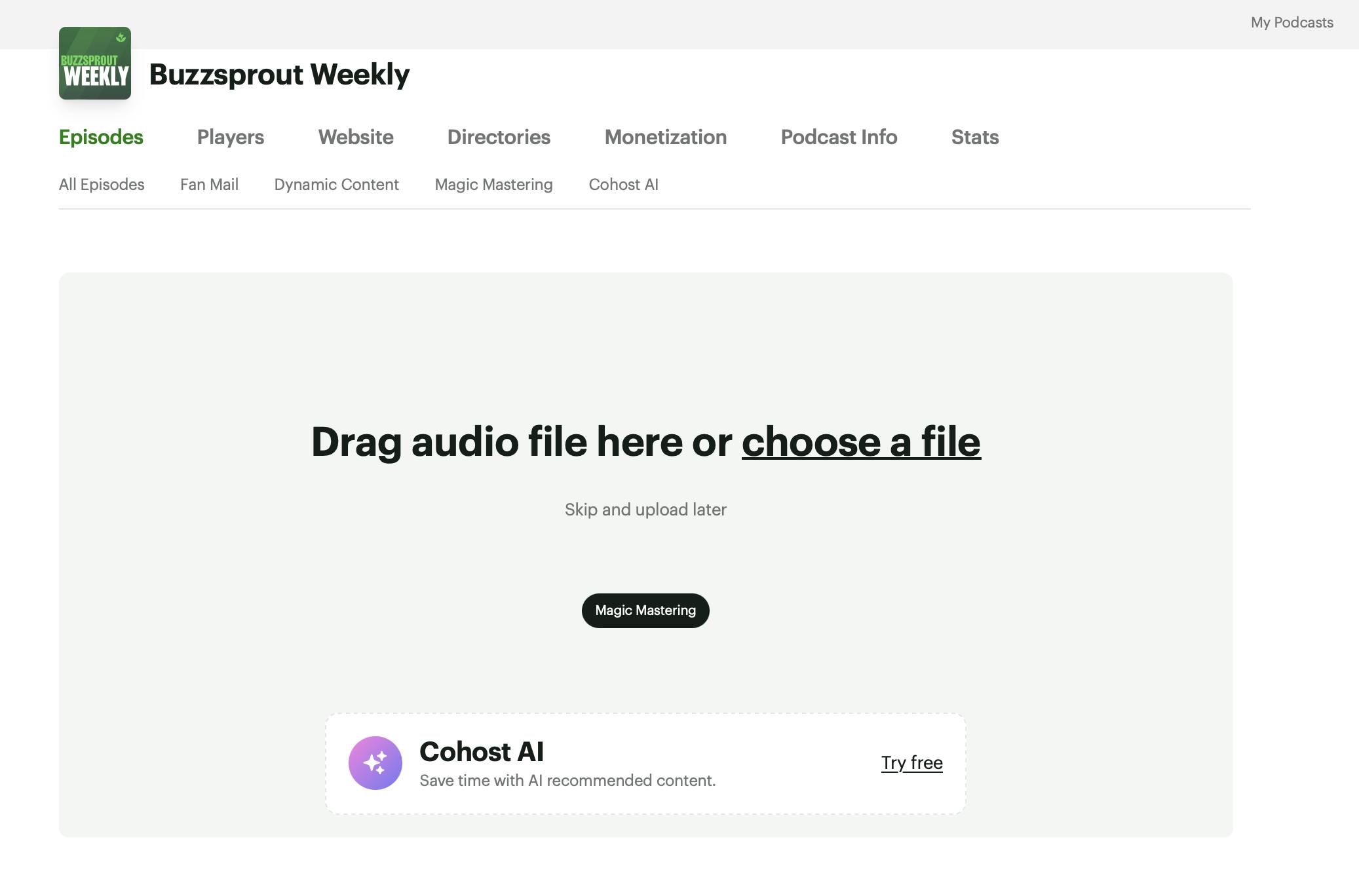
Fill out your podcast information
Go to Podcast Info inside Buzzsprout to fill in your podcast title, artwork, and description. This information helps you appear in search engine queries.
Your podcast description is where you tell listeners what they can expect from your content. It’s also a good place to use keywords to draw people’s attention.
If you have a business podcast, use related words and phrases so readers know your content is relevant to them.
Upload podcast artwork
Upload your podcast artwork into the designated field.
You can upload pre-made artwork or use click the Canva button to create your cover art within the dashboard.
Pick a podcast category
This is where you pick which category your podcast appears in Apple Podcasts (formerly iTunes).
Pick the category that best fits your podcast. You can always change this later.
You can also pick a subcategory to narrow your niche. It's better to be at the top of a subcategory than further down a general category.
Upload your first episode
Drag and drop your file into the dashboard and then schedule when you want it to go live.
Individual episodes have their own metadata, including an episode title, and can even have their own episode artwork.
Write podcast show notes
Your Episode Description is where you can write your show notes.
These notes show up with your episode in podcast apps and next to your episode on your podcast website. Quality show notes can help with your SEO and overall accessibility.

Try to include these things in your show notes:
- helpful links
- ancillary information
- contact information
- short summary of the episode
Most major apps support formatting within your episode notes, but not all do. Keep that in mind when you format your episode description text.
Bonus features in Buzzsprout
Now that you have the basics done, you can check out these extras to optimize your podcast.
Buzzsprout customizable website
Every podcast should have a website where your podcast lives. All Buzzsprout podcasters on paid plans can create a free customizable website where you can keep your transcripts and episodes and have more information on your podcast and hosts.
You can set up this website within Buzzsprout and put it on your own domain. This site is primarily for podcast listening, transcripts, and show notes.
Transcripts
Transcripts help with your accessibility. Some people just prefer to read rather than listen to your content.
Within Buzzsprout, you can transcribe your episodes using Cohost AI, a third-party transcription service, or transcribe them yourself. When the transcription is added, we’ll distribute it to every directory that supports the feature.
Magic Mastering
It’s challenging to fine-tune your audio. Magic Mastering levels out your audio, removes background noises and makes voices sound full.
Once you have an account, you can try out this feature for free on one episode!
Visual Soundbites
Visual Soundbites are video clips of your audio animated with your podcast artwork image and waveform.
These soundbites are a great way to promote on social media and stand out in someone’s feed. Posts with a visual component get an average of seven times the engagement.
RELATED YOUTUBE VIDEOS
9. Get listed in podcast directories
Podcast directories, like Apple Podcasts, are a centralized place for podcast listeners to find new shows.
Getting listed in the top podcast directories is a critical part of your podcast marketing strategy. Most of your new listeners will find your podcast through these directories.
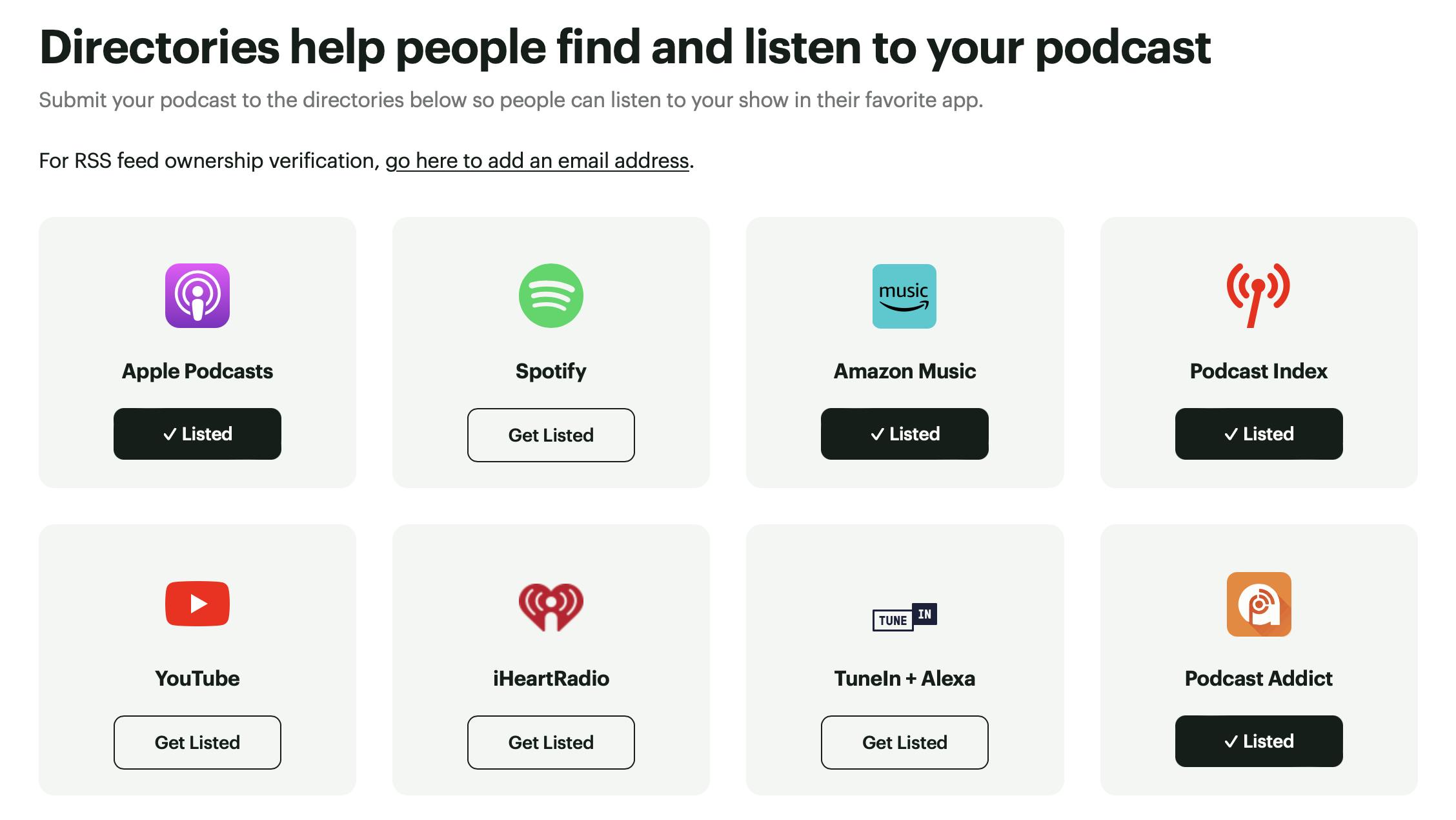
Here are the steps for getting listed in the top three major podcast directories.
Submit podcast to Apple Podcasts
Apple Podcasts is one of the world's biggest directories, accounting for 32.5% of all podcast downloads.
Here’s how to get into Apple Podcasts:
- Log in to Buzzsprout
- Go to the Directories tab
- Click Get Listed under Apple Podcasts
- Log in to Apple Podcasts Connect
- Click Validate
- Click Submit
It can take up to 24 hours for a podcast to be approved, as Apple does a human review of every new podcast. You'll receive an email once your show is approved.
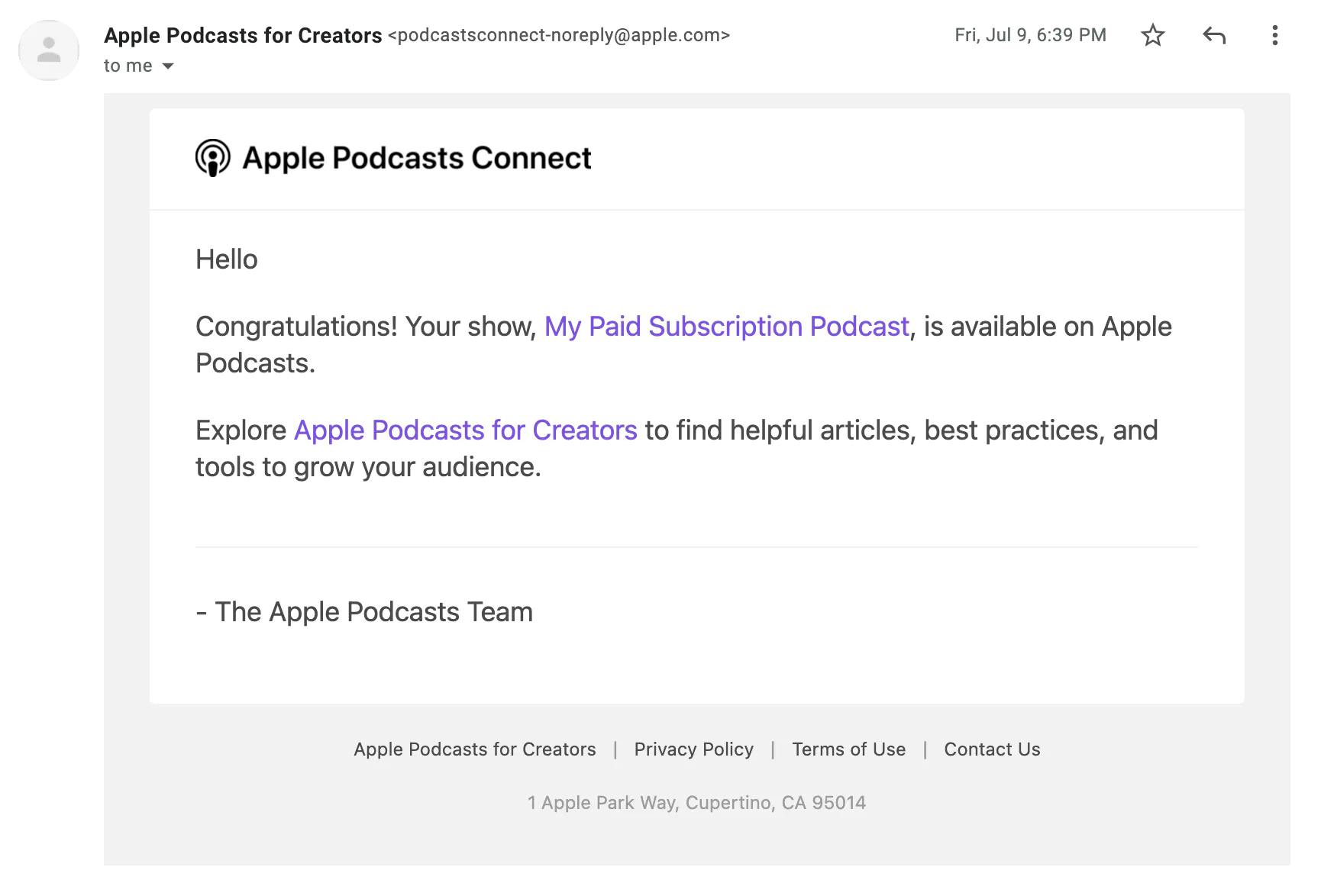
Submit podcast to Spotify
Spotify launched its directory in 2018 and is now the largest podcast directory, with 34.4% of all podcast downloads.
Here's how to get listed on Spotify:
- Login to Buzzsprout
- Go to the Directories tab
- Select Get Listed under Spotify
- Select Submit Podcast to Spotify
Once you submit your podcast to Spotify, it should be listed almost immediately.
Other podcast directories
Once you get listed in Apple Podcasts and Spotify, your podcast is in front of most podcast listeners!
Submit to these smaller directories to further broaden your reach:
10. Launch and grow your show
When it’s time to launch your podcast, you have two options. Choose whichever one feels best to you.
Strategy #1: The grand opening
A grand opening is when you build hype for your show before its launch. This is the approach used by most podcasters with an existing following.
Pick a launch date a few weeks away and reach out to people who might be interested.
You can pay for ads, submit to Apple Podcasts’ New and Noteworthy, or reach out to publications.
Strategy #2: The soft open
A soft open is more discreet. With this method, you publish episodes as if people are listening, but wait to promote your episodes.
This strategy lets you get comfortable, iron out kinks, and overcome imposter syndrome.
When you see your podcast succeed in a lower-pressure environment, promoting it more confidently is easier.
Imposter syndrome
A lot of podcasters feel like a fraud when they first start. Maybe you dislike your voice or feel inadequate to speak on your topic.
It’s easy to sideline yourself, but you have a valuable perspective to offer. Know that this is a normal phase of podcasting that gets easier.
7 Marketing tips to grow your listenership
It takes time to get the word out about your podcast. Follow these five steps to build a successful podcast marketing strategy.
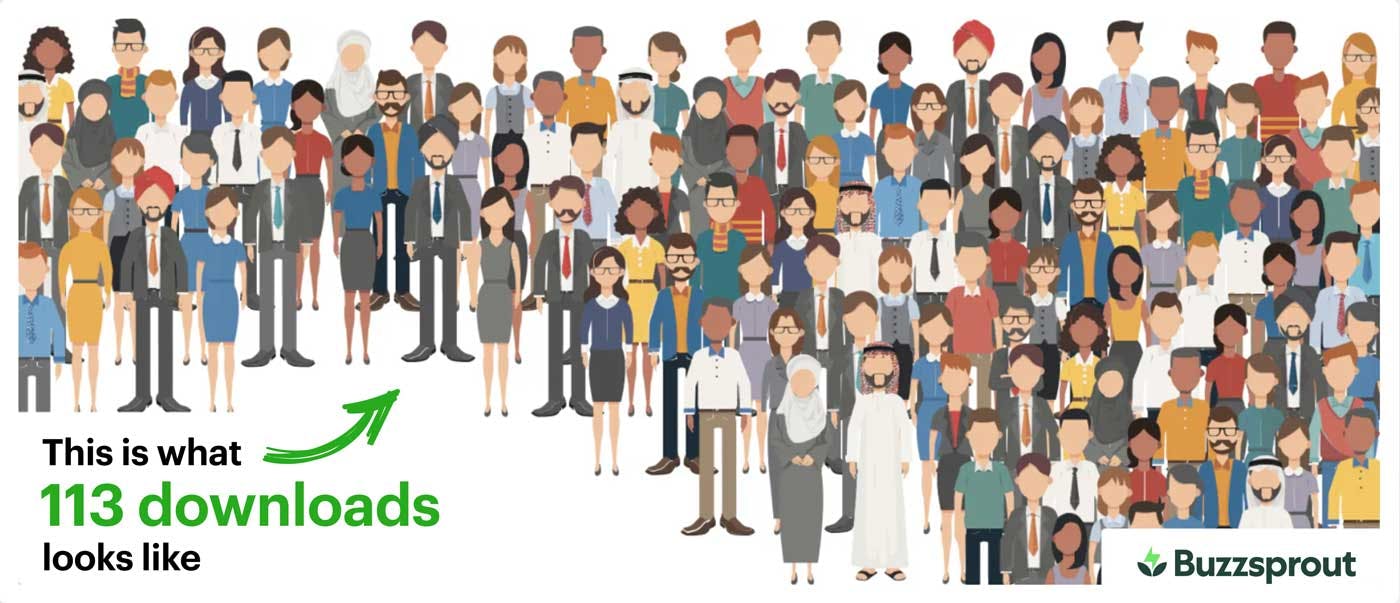
1. Share your podcast with friends and family
Share your podcast with loved ones and ask for feedback. You can get their honest opinions and have them leave your first reviews on Apple Podcasts.
2. Create a Buzzsprout Ad
You can grow your listenership by running a podcast promo with Buzzsprout Ads. Podcast promos are more effective than traditional ads since they target the right audience for your show.
When you create a Buzzsprout podcast promo you:
- target people who listen to podcasts
- find listeners already interested in your podcast's topic
- reach 10,000 listeners for just $200
When listeners click on your ad, they’ll be taken to your podcast page, where they can subscribe to your show and get notified of new episodes.
3. Post episodes on social media
Sharing podcast content on social media helps you build a connection with your listeners that can be hard to achieve over just audio.
You can create Visual Soundbites for Facebook, Instagram, and TikTok, boost tweets on Twitter, and post content on LinkedIn. If you do this right, you could pick up ten new listeners over your first few episodes.
If you’re comfortable filming yourself, we’ve seen multiple podcasts go viral after posting original content to TikTok.
4. Join groups and forums
Providing value on forums like Reddit, Quora, or Facebook groups helps direct people to your podcast.
Respond to relevant, recent questions you can confidently answer. Include a link to one episode to direct your podcast traffic.
Aim to post one or two answers like this for each new episode.
5. Cross-promote with other creators
Cross-promotion lets you partner with other podcasters and promote each other’s shows.
This marketing method lets you get your podcast in front of a new audience.
You can contact fellow creators on Podchaser or find hosts' contact information on their websites or social media.
6. Overcast Ads
The Overcast podcast app runs ads exclusively for podcasting. In our experience, we get 100 new subscribers each ad cycle. This is an excellent way to get your first 100 subscribers if you have the money.
7. Create a call to action
A call to action (CTA) is one thing you ask your listeners to do after listening to an episode, and it can be a powerful way to reach your podcasting goals. You can ask listeners to:
- subscribe to your show and leave a review
- download a lead magnet
- sign up for your email newsletter, etc.
Just make sure to limit yourself to one CTA per episode so you don’t overwhelm your listeners.
Free resources
If you encounter any issues during your launch or have questions while podcasting, consult these Buzzsprout resources.
- Buzzsprout Podcast Community on Facebook
- Buzzsprout Blog and YouTube channel
- Buzzsprout’s support team: support@buzzsprout.com
Celebrate your launch!
If you've made it this far and are ready to publish your episode, we encourage you to submit it soon and celebrate your accomplishment.
Launching your first podcast is an achievement, so congratulations from the entire Buzzsprout team! We can't wait to see how far your podcast takes you.
Alban Brooke
Alban Brooke is the Head of Marketing at Buzzsprout and the co-host of Buzzcast. Have any questions about this guide? Reach out on Twitter.
Frequently Asked Questions
How much does it cost to start a podcast?
The cost of starting a podcast varies depending on the quality of the podcast equipment you purchase. If you already have a computer and start with more affordable options, you can spend $60-100 on a microphone and headphones. If you purchase an audio interface, podcast recording software, and higher-quality gear, you can spend over $1,000.
Do podcasters make money?
Yes, podcasters can make money through various direct and indirect monetization methods, including sponsorships, paid subscriptions, selling physical products, and online courses. However, the amount earned depends on factors such as the size and engagement of the audience, as well as the chosen monetization strategies. Nonetheless, with proper planning and execution, podcasting can be a lucrative venture.
How do I start a podcast with no experience?
Starting a podcast without experience requires a solid marketing strategy to attract new listeners. The best podcast marketing channels include social media, getting listed in directories like Apple Podcasts and Spotify, optimizing new episodes for SEO, and publishing consistently.
